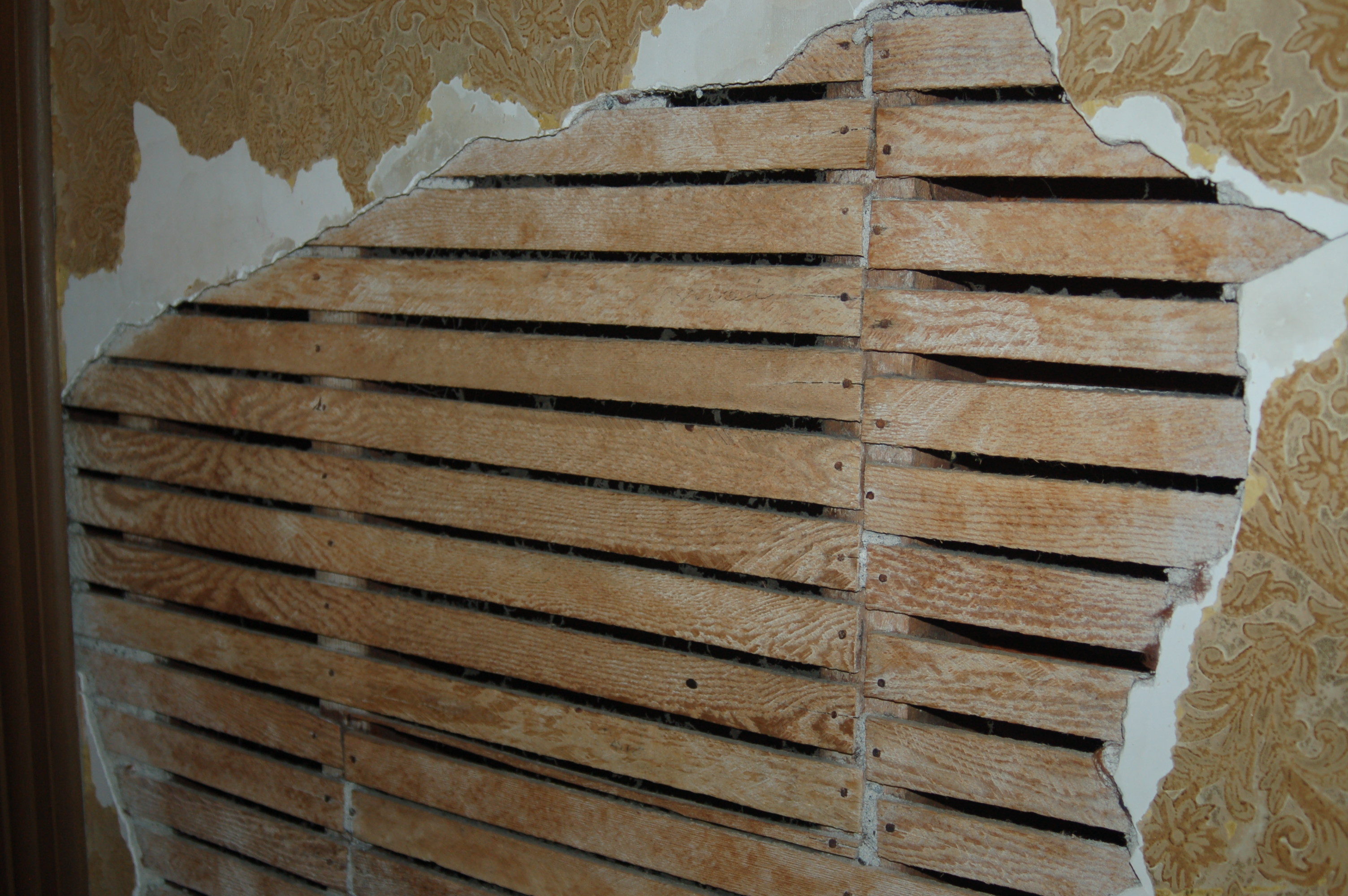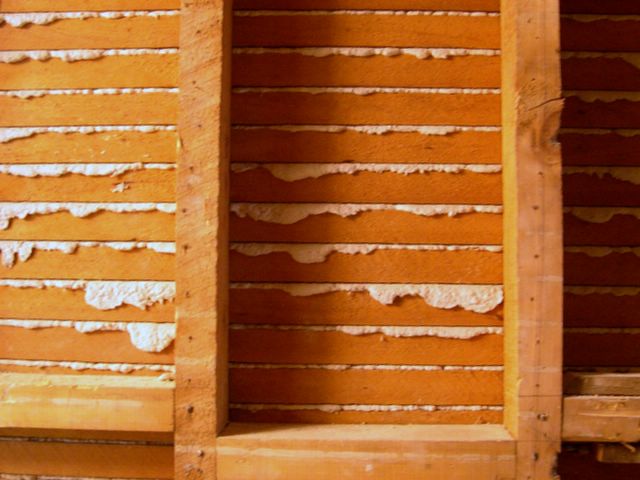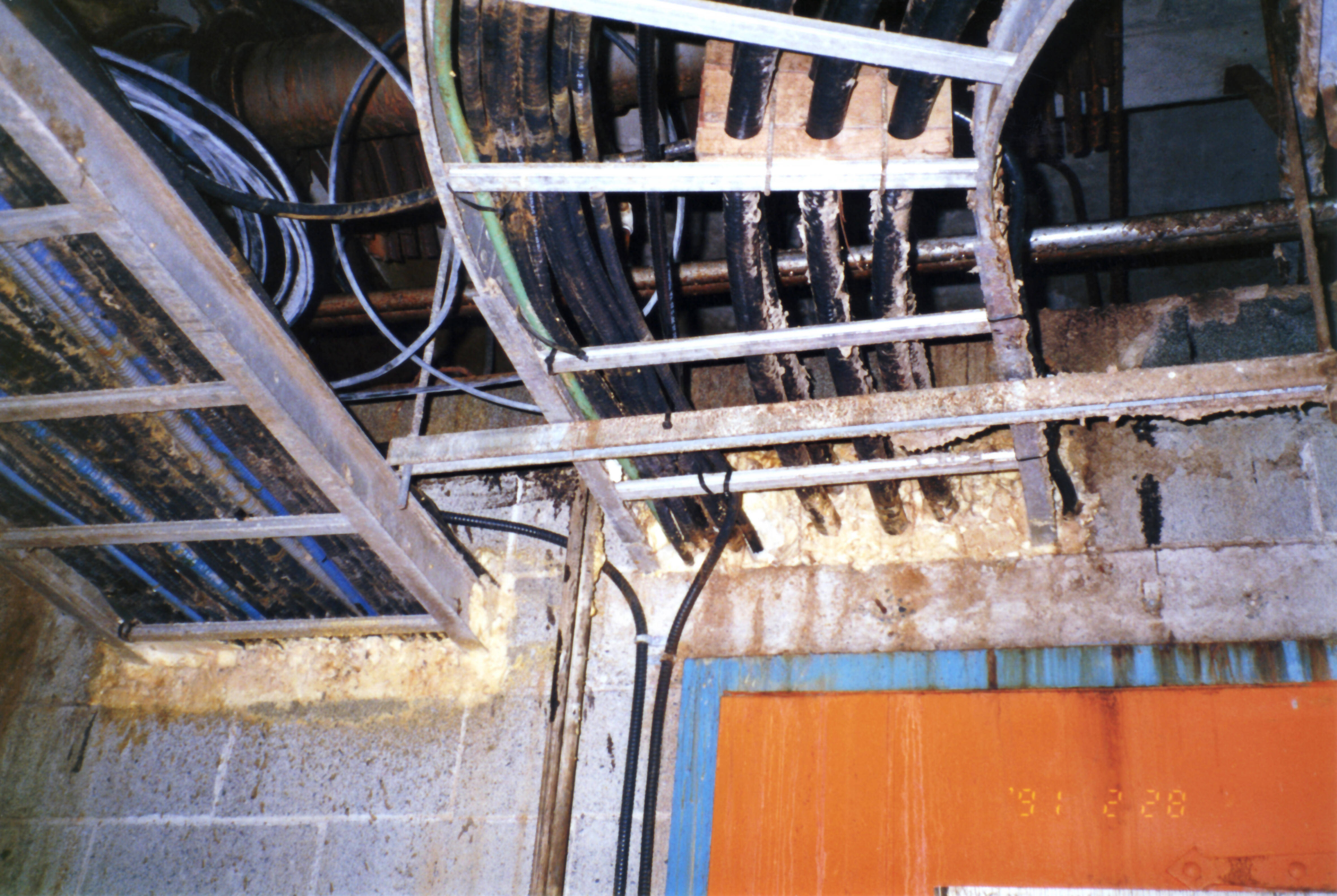|
Lath And Plaster
Lath and plaster is a building process used to finish mainly interior dividing walls and ceilings. It consists of narrow strips of wood (laths) which are nailed horizontally across the wall studs or ceiling joists and then coated in plaster. The technique derives from an earlier, more primitive process called wattle and daub. Lath and plaster largely fell out of favour in the U.K. after the introduction of plasterboard in the 1930s.Jeff Howell''On the level: is the old plaster best?'' The Telegraph (London), May 10, 2006. Retrieved 2012-03-30. In Canada and the United States, wood lath and plaster remained in use until the process was replaced by transitional methods followed by drywall (the North American term for plasterboard) in the mid-twentieth century. Description The wall or ceiling finishing process begins with wood or metal laths. These are narrow strips of wood, extruded metal, or split boards, nailed horizontally across the wall studs or ceiling joists. Each w ... [...More Info...] [...Related Items...] OR: [Wikipedia] [Google] [Baidu] |
Lath
A lath or slat is a thin, narrow strip of straight-grained wood used under roof shingles or tiles, on lath and plaster walls and ceilings to hold plaster, and in lattice and trellis work. ''Lath'' has expanded to mean any type of backing material for plaster. This includes metal wire mesh or expanded metal that is applied to a wood or metal framework as matrix over which stucco or plaster is applied, as well as drywall products called gypsum or rock lath.Ching, Frank. ''A visual dictionary of architecture''. New York: Van Nostrand Reinhold, 1995. 198. Print. Historically, reed mat was also used as a lath material. One of the key elements of lath, whether wooden slats or wire mesh, are the openings or gaps that allow plaster or stucco to ooze behind and form a mechanical bond to the lath. This is not necessary for gypsum lath, which relies on a chemical bond. Etymology The word is recorded from the late 13th century and is likely derived from the Old English word *, a ... [...More Info...] [...Related Items...] OR: [Wikipedia] [Google] [Baidu] |
United Kingdom
The United Kingdom of Great Britain and Northern Ireland, commonly known as the United Kingdom (UK) or Britain, is a country in Northwestern Europe, off the coast of European mainland, the continental mainland. It comprises England, Scotland, Wales and Northern Ireland. The UK includes the island of Great Britain, the north-eastern part of the island of Ireland, and most of List of islands of the United Kingdom, the smaller islands within the British Isles, covering . Northern Ireland shares Republic of Ireland–United Kingdom border, a land border with the Republic of Ireland; otherwise, the UK is surrounded by the Atlantic Ocean, the North Sea, the English Channel, the Celtic Sea and the Irish Sea. It maintains sovereignty over the British Overseas Territories, which are located across various oceans and seas globally. The UK had an estimated population of over 68.2 million people in 2023. The capital and largest city of both England and the UK is London. The cities o ... [...More Info...] [...Related Items...] OR: [Wikipedia] [Google] [Baidu] |
Building Engineering
Architectural engineering or architecture engineering, also known as building engineering, is a Academic discipline, discipline that deals with the engineering and construction of buildings, such as environmental, structural, mechanical, electrical, computational, embeddable, and other research domains. It is related to Architecture, Mechatronics Engineering, Computer engineering, Computer Engineering, Aerospace engineering, Aerospace Engineering, and civil engineering, Civil Engineering, but distinguished from Interior design, Interior Design and architectural design, Architectural Design as an art and science of designing infrastructure through these various engineering disciplines, from which properly align with many related surrounding engineering advancements. From reduction of greenhouse gas emissions to the construction of resilient buildings, architectural engineers are at the forefront of addressing several major challenges of the 21st century. They apply the latest scie ... [...More Info...] [...Related Items...] OR: [Wikipedia] [Google] [Baidu] |
Stucco
Stucco or render is a construction material made of aggregates, a binder, and water. Stucco is applied wet and hardens to a very dense solid. It is used as a decorative coating for walls and ceilings, exterior walls, and as a sculptural and artistic material in architecture. Stucco can be applied on construction materials such as metal, expanded metal lath, concrete, cinder block, or clay brick and adobe for decorative and structural purposes. In English, "stucco" sometimes refers to a coating for the outside of a building and " plaster" to a coating for interiors. As described below, however, the materials themselves often have little or no difference. Other European languages, notably Italian, do not have the same distinction: ''stucco'' means ''plaster'' in Italian and serves for both. Composition The basic composition of stucco is lime, water, and sand. The difference in nomenclature between stucco, plaster, and mortar is based more on use than composition. ... [...More Info...] [...Related Items...] OR: [Wikipedia] [Google] [Baidu] |
Building Code
A building code (also building control or building regulations) is a set of rules that specify the standards for construction objects such as buildings and non-building structures. Buildings must conform to the code to obtain planning permission, usually from a local council. The main purpose of building codes is to protect public health, safety and general welfare as they relate to the construction and occupancy of buildings and for example, the building codes in many countries require engineers to consider the effects of soil liquefaction in the design of new buildings. The building code becomes law of a particular jurisdiction when formally enacted by the appropriate governmental or private authority. Building codes are generally intended to be applied by architects, engineers, interior designers, constructors and regulators but are also used for various purposes by safety inspectors, environmental scientists, real estate developers, subcontractors, manufacturers of b ... [...More Info...] [...Related Items...] OR: [Wikipedia] [Google] [Baidu] |
Furring
In construction, furring (furring strips) are strips of wood or other material applied to a structure to level or raise the surface, to prevent dampness, to make space for insulation, to level and resurface ceilings or walls, or to increase the beam of a wooden ship. Furring refers to the process of installing the strips and to the strips themselves. ''Firring'' is a U.K. term for wood strips which are usually 50 mm wide, tapered and fixed above wood roof joists to provide drainage falls below roof boarding. Furring strips themselves are typically referred to as ''battens'' in the U.K. and sometimes the material is called ''strapping'' in the U.S. In buildings Wood furring strips typically measure 1 x 2 or 1 x 3 inches. They can be laid out perpendicular to studs or joists and nailed to them, or set vertically against an existing wall surface. The spacing between the strips depends on the type of finishing material. Wider spacing is typically used behind the heavy boards tha ... [...More Info...] [...Related Items...] OR: [Wikipedia] [Google] [Baidu] |
Galvanized
Galvanization ( also spelled galvanisation) is the process of applying a protective zinc coating to steel or iron, to prevent rusting. The most common method is hot-dip galvanizing, in which the parts are coated by submerging them in a bath of hot, molten zinc. Protective action The zinc coating, when intact, prevents corrosive substances from reaching the underlying iron. It's main function is to act as a sacrificial anode to prevent the iron from rusting by cathodic protection. Zinc is more reactive than iron, so the zinc coating preferentially oxidizes to zinc carbonate, preventing the iron from corroding, even if there are gaps in the zinc coating. Additional electroplating such as a chromate conversion coating may be applied to provide further surface passivation to the substrate material. History and etymology The process is named after the Italian physician, physicist, biologist and philosopher Luigi Galvani (9 September 1737 – 4 December 1798). The earlies ... [...More Info...] [...Related Items...] OR: [Wikipedia] [Google] [Baidu] |
Horsehair
Horsehair is the long hair growing on the Mane (horse), manes and Tail (horse), tails of horses. It is used for various purposes, including upholstery, brushes, the Bow (music), bows of musical instruments, a hard-wearing Textile, fabric called haircloth, and for Lath and plaster, horsehair plaster, a wallcovering material formerly used in the construction industry and now found only in older buildings. Horsehair can be rough and knotted and dirty messes or very fine and flexible; mane hair is generally softer and shorter than tail hair. The texture of horsehair can be influenced by the breed and management of the horse, including natural conditions such as diet or climate. Processing may also affect quality and feel. Horsehair is a protein fiber that absorbs water slowly, but can be dyed or colored effectively using traditional dyes suitable for protein fibers. It can be felted, but not easily. Uses Horsehair fabrics are woven with wefts of tail hair from live horses and c ... [...More Info...] [...Related Items...] OR: [Wikipedia] [Google] [Baidu] |
Lime Plaster
Lime plaster is a type of plaster composed of sand, water, and lime, usually non-hydraulic hydrated lime (also known as slaked lime, high calcium lime or air lime). Ancient lime plaster often contained horse hair for reinforcement and pozzolan additives to reduce the working time. Traditional non-hydraulic hydrated lime only sets through carbonatation when the plaster is kept moist and access of CO2 from the air is possible. It will not set when submersed in water. When a very thick layer or several layers are applied, the lime can remain soft for weeks. The curing time of lime plaster can be shortened by using (natural) hydraulic lime or adding pozzolan additives, transforming it into artificially hydraulic lime. In ancient times, Roman lime plaster incorporated pozzolanic volcanic ash; in modern times, fly ash is preferred. Non-hydraulic lime plaster can also be made to set faster by adding gypsum. Lime production for use in plastering home-made cisterns (in making them im ... [...More Info...] [...Related Items...] OR: [Wikipedia] [Google] [Baidu] |
Gypsum
Gypsum is a soft sulfate mineral composed of calcium sulfate Hydrate, dihydrate, with the chemical formula . It is widely mined and is used as a fertilizer and as the main constituent in many forms of plaster, drywall and blackboard or sidewalk chalk. Gypsum also Crystallization, crystallizes as translucent crystals of selenite (mineral), selenite. It forms as an evaporite mineral and as a Mineral hydration, hydration product of anhydrite. The Mohs scale of mineral hardness defines gypsum as hardness value 2 based on Scratch hardness, scratch hardness comparison. Fine-grained white or lightly tinted forms of gypsum known as alabaster have been used for sculpture by many cultures including Ancient Egypt, Mesopotamia, Ancient Rome, the Byzantine Empire, and the Nottingham alabasters of Medieval England. Etymology and history The word ''wikt:gypsum, gypsum'' is derived from the Greek language, Greek word (), "plaster". Because the quarry, quarries of the Montmartre district of P ... [...More Info...] [...Related Items...] OR: [Wikipedia] [Google] [Baidu] |
Lime (material)
Lime is an Inorganic compound, inorganic material composed primarily of calcium oxides and hydroxides. It is also the name for calcium oxide which is used as an industrial mineral and is made by heating calcium carbonate in a kiln. Calcium oxide can occur as a product of coal-seam fires and in altered limestone xenoliths in volcanic ejecta. The International Mineralogical Association recognizes lime as a mineral with the chemical formula of CaO. The word ''lime'' originates with its earliest use as building mortar and has the sense of ''sticking or adhering''. These materials are still used in large quantities in the manufacture of steel and as building and engineering materials (including limestone products, cement, concrete, and mortar (masonry), mortar), as chemical feedstocks, for sugar refining, and other uses. Lime industries and the use of many of the resulting products date from prehistoric times in both the Old World and the New World. Lime is used extensively for was ... [...More Info...] [...Related Items...] OR: [Wikipedia] [Google] [Baidu] |









